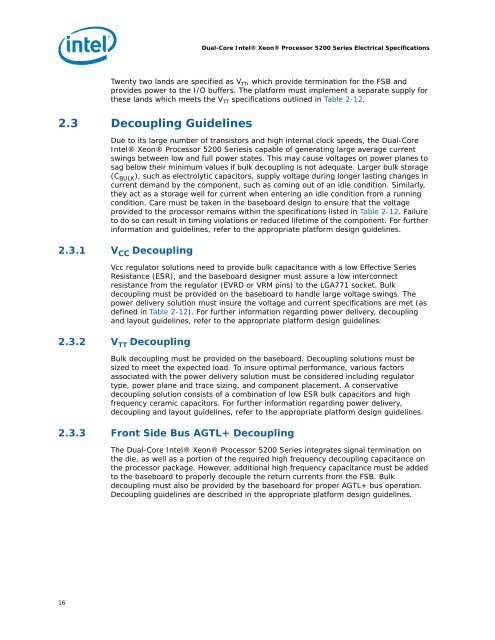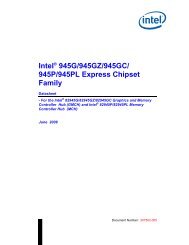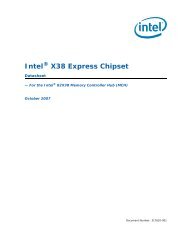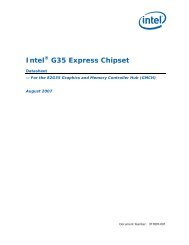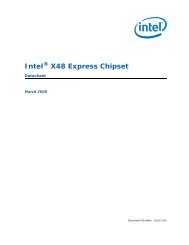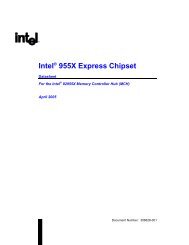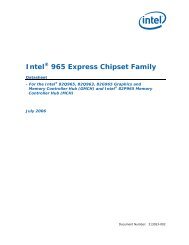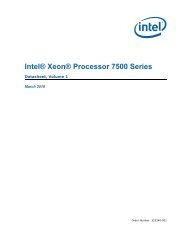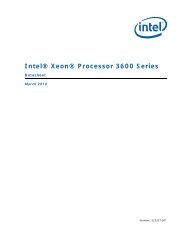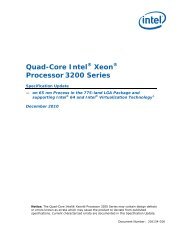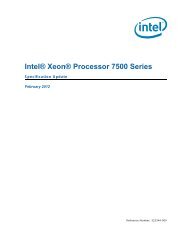Dual-Core Intel® Xeon® Processor 5200 Series
Dual-Core Intel® Xeon® Processor 5200 Series
Dual-Core Intel® Xeon® Processor 5200 Series
You also want an ePaper? Increase the reach of your titles
YUMPU automatically turns print PDFs into web optimized ePapers that Google loves.
16<br />
<strong>Dual</strong>-<strong>Core</strong> <strong>Intel®</strong> <strong>Xeon®</strong> <strong>Processor</strong> <strong>5200</strong> <strong>Series</strong> Electrical Specifications<br />
Twenty two lands are specified as V TT, which provide termination for the FSB and<br />
provides power to the I/O buffers. The platform must implement a separate supply for<br />
these lands which meets the V TT specifications outlined in Table 2-12.<br />
2.3 Decoupling Guidelines<br />
Due to its large number of transistors and high internal clock speeds, the <strong>Dual</strong>-<strong>Core</strong><br />
<strong>Intel®</strong> <strong>Xeon®</strong> <strong>Processor</strong> <strong>5200</strong> <strong>Series</strong>is capable of generating large average current<br />
swings between low and full power states. This may cause voltages on power planes to<br />
sag below their minimum values if bulk decoupling is not adequate. Larger bulk storage<br />
(C BULK ), such as electrolytic capacitors, supply voltage during longer lasting changes in<br />
current demand by the component, such as coming out of an idle condition. Similarly,<br />
they act as a storage well for current when entering an idle condition from a running<br />
condition. Care must be taken in the baseboard design to ensure that the voltage<br />
provided to the processor remains within the specifications listed in Table 2-12. Failure<br />
to do so can result in timing violations or reduced lifetime of the component. For further<br />
information and guidelines, refer to the appropriate platform design guidelines.<br />
2.3.1 V CC Decoupling<br />
Vcc regulator solutions need to provide bulk capacitance with a low Effective <strong>Series</strong><br />
Resistance (ESR), and the baseboard designer must assure a low interconnect<br />
resistance from the regulator (EVRD or VRM pins) to the LGA771 socket. Bulk<br />
decoupling must be provided on the baseboard to handle large voltage swings. The<br />
power delivery solution must insure the voltage and current specifications are met (as<br />
defined in Table 2-12). For further information regarding power delivery, decoupling<br />
and layout guidelines, refer to the appropriate platform design guidelines.<br />
2.3.2 V TT Decoupling<br />
Bulk decoupling must be provided on the baseboard. Decoupling solutions must be<br />
sized to meet the expected load. To insure optimal performance, various factors<br />
associated with the power delivery solution must be considered including regulator<br />
type, power plane and trace sizing, and component placement. A conservative<br />
decoupling solution consists of a combination of low ESR bulk capacitors and high<br />
frequency ceramic capacitors. For further information regarding power delivery,<br />
decoupling and layout guidelines, refer to the appropriate platform design guidelines.<br />
2.3.3 Front Side Bus AGTL+ Decoupling<br />
The <strong>Dual</strong>-<strong>Core</strong> <strong>Intel®</strong> <strong>Xeon®</strong> <strong>Processor</strong> <strong>5200</strong> <strong>Series</strong> integrates signal termination on<br />
the die, as well as a portion of the required high frequency decoupling capacitance on<br />
the processor package. However, additional high frequency capacitance must be added<br />
to the baseboard to properly decouple the return currents from the FSB. Bulk<br />
decoupling must also be provided by the baseboard for proper AGTL+ bus operation.<br />
Decoupling guidelines are described in the appropriate platform design guidelines.


